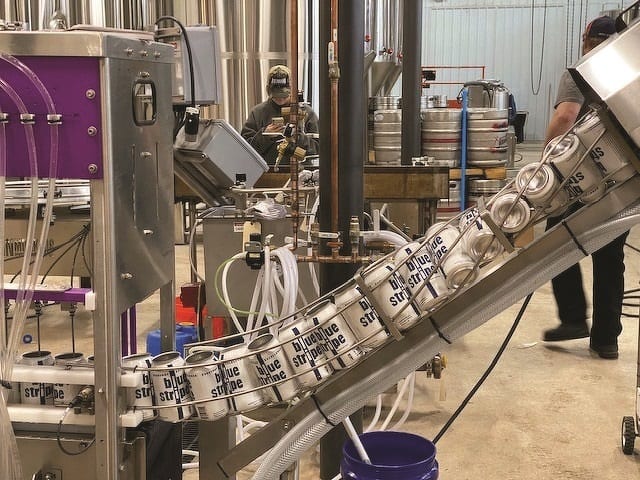
no description

no description
Axemann Brewery, one of Centre County’s newest breweries, was hoping to open the doors to its taproom this spring in Bellefonte. All of its plans changed when the COVID-19 pandemic hit.
While the building on Axemann Road in Bellefonte is still not open for the public, Axemann has been brewing and selling its beer during the shutdown caused by the coronavirus. The brewery has canned beers such as its flagship Blue Stripe, a German kolsch-style brew; Hop Alloy, an IPA; Hazy Daisy, a New England-style, hazy IPA; and Pilatus Pilsner. The beers are sold at many of the region’s distributors.
“Support from the local population has been great with our initial offerings,” Axemann Brewery founder Rod Stahl says. “We are very glad that we are located and live here in the Centre Region.”
Since the pandemic, Centre County has shown its support for local businesses, including the region’s breweries.
“The community has been super-supportive from what I’ve witnessed,” says Caleb Peachey, who took over as head brewer at Robin Hood Brewing in December. “We’ve seen people picking up growlers or getting take-out food. … Beer is essential, after all!”
Craft breweries across the country have struggled since the pandemic, according to several national publications. In April, Forbes reported on a study by InMarket that showed the less expensive and lighter-calorie beers, such as Busch Light and Miller, were experiencing the biggest increases in sales, including some double-digit increases.
InMarket CEO Todd Dipaola told Forbes that “as COVID was approaching and you couldn’t go out, people were buying beer and particular kinds of beer. In this case, they were buying more of the kind on the lower end of the beer spectrum, where it was cheaper and low-calorie.”
A USA Today story in April painted an even more dire picture for craft brewers. A survey from the Brewers Association found that when stay-at-home orders began to happen, “the typical brewery experienced on-site beer sale declines of 65 percent, with draft sales falling about 95 percent,” according to the story.
The story also reported that the United States had seen more than 5,000 new breweries open in the past five years, bringing the total to an all-time high of 8,150. “But as many as 4,800 could go out of business if the shutdown continues through mid-June, the survey results suggest.”
So far, breweries in Centre County have held their own. Peachey says that the same beers that were popular for Robin Hood before the pandemic continue to be popular now, including Bulls IPA and flavored wheat beers.
Happy Valley Brewery in State College also has seen loyal customers ordering beer and food for take-out. When the shutdown orders came down from Governor Tom Wolf, brewer Chris Good suggested to general manager Celesta Powell that the brewery should sell “crowlers” to-go at $5 per crowler each Friday between 4 and 7 p.m.
“We made a crazy happy hour if you will,” Powell says. “Those first couple of crowler days were amazing. Talk about great mental health – after businesses came to a screeching halt, it was amazing to see everyone. We saw so many people come out for a 32-ounce beer at $5.”
Breweries, along with many businesses and organizations, have become creative, out of necessity, in how to attract customers. Robin Hood started giving away free rolls of toilet paper for every food order, and Happy Valley Brewery started Chef’s Warehouse sales where it sells box sets of meat.
The brewers also are continuing to make new beers for customers to enjoy.
“With so many breweries opening anymore, it can be hard to stay relevant,” Peachey says. “I try to put two to three new beers out a month. … I take pride in thinking outside the box when it comes to my style of brewing. I’ll make the standard ales and lagers, but then on the other available taps I’ll try to throw together something special.
“The unknown is the scary part of all this. Right now, it’s very important to help support the smaller breweries because the biggest ones will stay afloat, while smaller ones may be forced to close.”
The unknown is making it hard for everyone, including breweries, to plan for the future, even the near future.
Stahl says he isn’t sure what the rest of the year will be like with regards to having the taproom open. “We just want to get open to get an idea of the sales distribution of our product, between cans, kegs, and taproom sales,” he says.
Because most craft brewers are creative by nature, the breweries, as much as they can, will continue to look for new ways to sell their beer to customers during these times.
“Each day in the world is a brand new one,” Powell says. “What we see is the industry is pretty creative. It will really depend on how trim operations have been – brewers are creative and really are a young, innovative part of Pennsylvania commerce.”
Peachey probably speaks for all brewers when he says, “We couldn’t remain open for long without the community supporting us, so for that I’m forever thankful. I can’t wait to share a beer with all of you when things return to normal. We’ll get through this!”
David Pencek is a freelance writer in State College.
Receive all the latest news and events right to your inbox.

80% of consumers turn to directories with reviews to find a local business.